ACC621 Auditing Assignment: Audit Plan for Chartreuse Enterprises
VerifiedAdded on 2023/06/07
|13
|2478
|241
Report
AI Summary
This assignment provides a comprehensive audit plan for Chartreuse Enterprises, addressing key aspects such as materiality assessment, analytical review, and fraud risk analysis. The document begins by revisiting and recalculating the materiality level, emphasizing the importance of setting appropriate limits to ensure that significant accounts are not overlooked during the audit process. A preliminary analytical review, including trend analysis, is conducted to identify potential risks of material misstatement, with justifications provided for selecting specific accounts for audit testing. The assignment outlines the necessary audit procedures for gathering evidence related to sales, depreciation expenses, and wages, including Pareto analysis, vouching of invoices, and scrutiny of depreciation methods and labor costs. Furthermore, it critiques the audit partner's suggestion to forego fraud risk checking, arguing for the importance of professional skepticism and highlighting specific areas where fraud analysis should be conducted, such as superannuation expenses, repairs and maintenance expenditure, and interest expense. This assignment is available on Desklib, where students can find a wide range of study resources, including past papers and solved assignments.
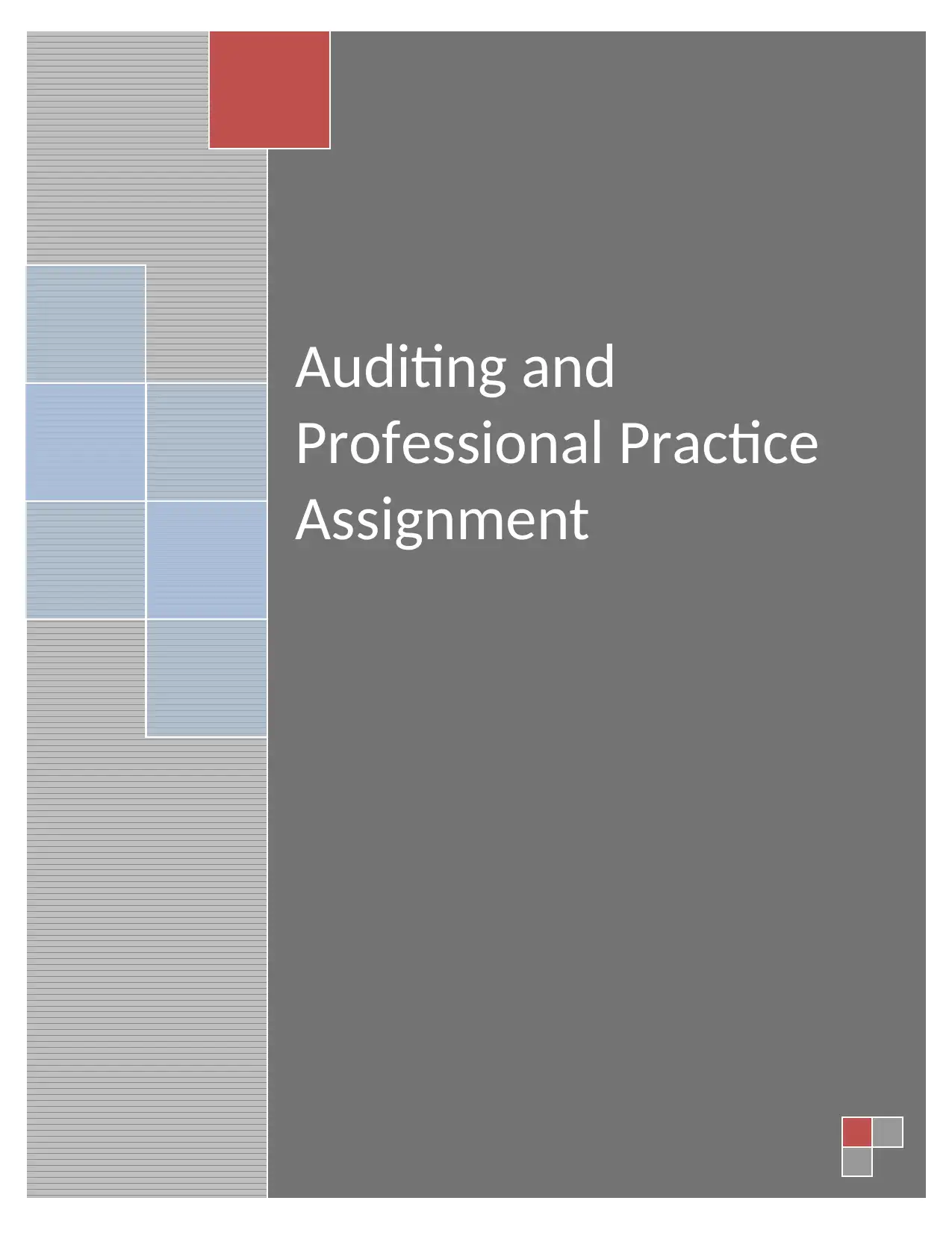
Auditing and
Professional Practice
Assignment
Professional Practice
Assignment
Paraphrase This Document
Need a fresh take? Get an instant paraphrase of this document with our AI Paraphraser
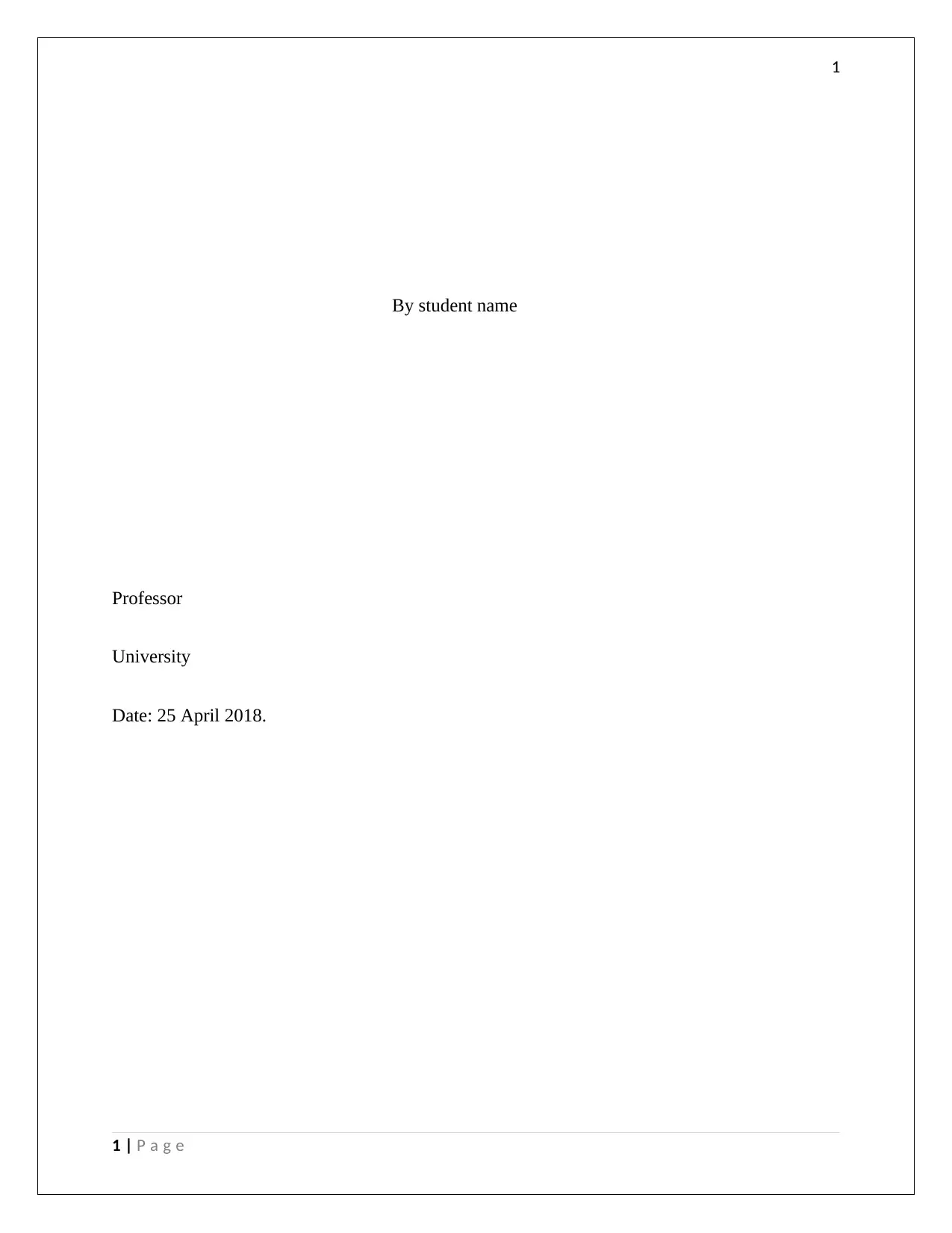
1
By student name
Professor
University
Date: 25 April 2018.
1 | P a g e
By student name
Professor
University
Date: 25 April 2018.
1 | P a g e
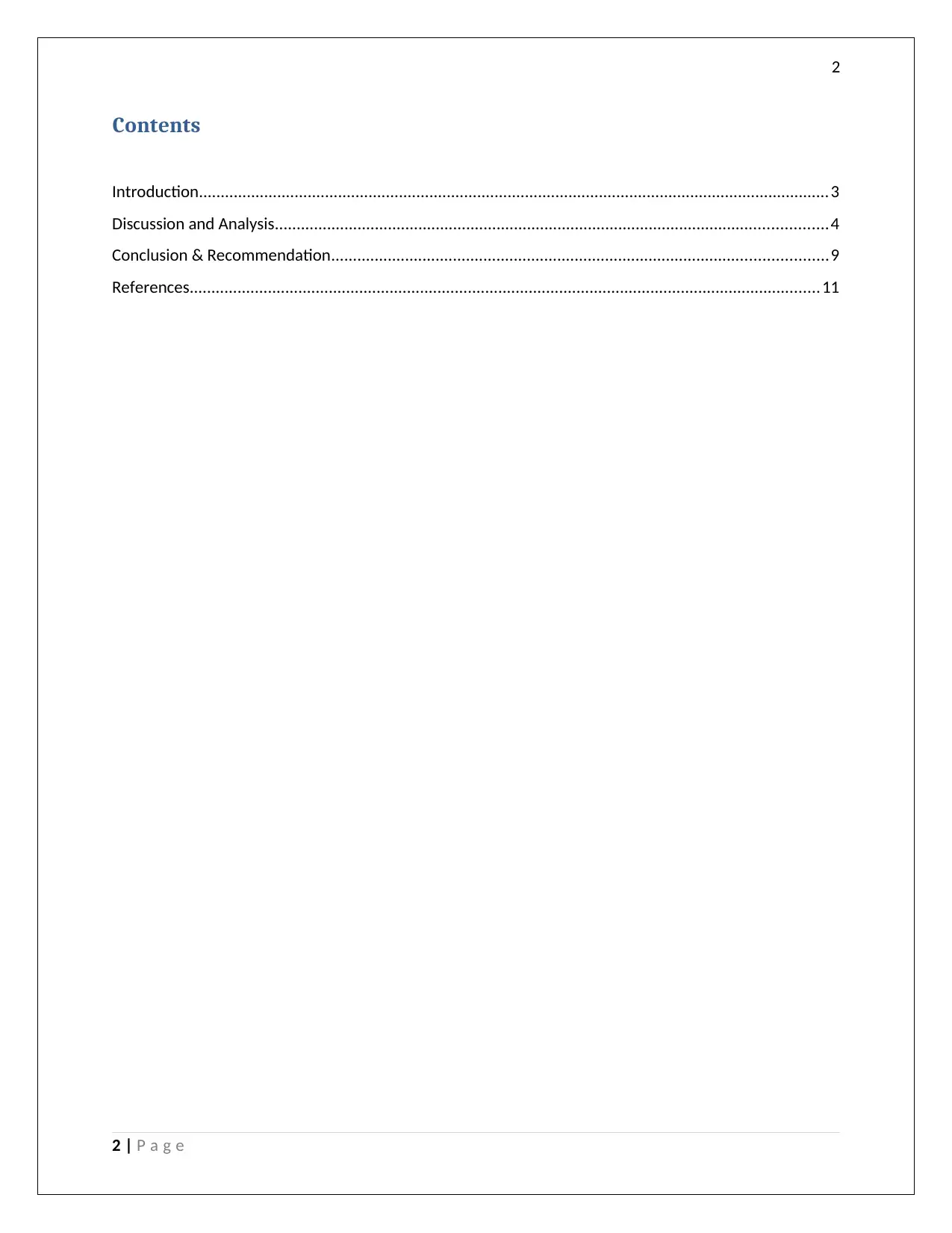
2
Contents
Introduction.................................................................................................................................................3
Discussion and Analysis...............................................................................................................................4
Conclusion & Recommendation..................................................................................................................9
References.................................................................................................................................................11
2 | P a g e
Contents
Introduction.................................................................................................................................................3
Discussion and Analysis...............................................................................................................................4
Conclusion & Recommendation..................................................................................................................9
References.................................................................................................................................................11
2 | P a g e
⊘ This is a preview!⊘
Do you want full access?
Subscribe today to unlock all pages.

Trusted by 1+ million students worldwide
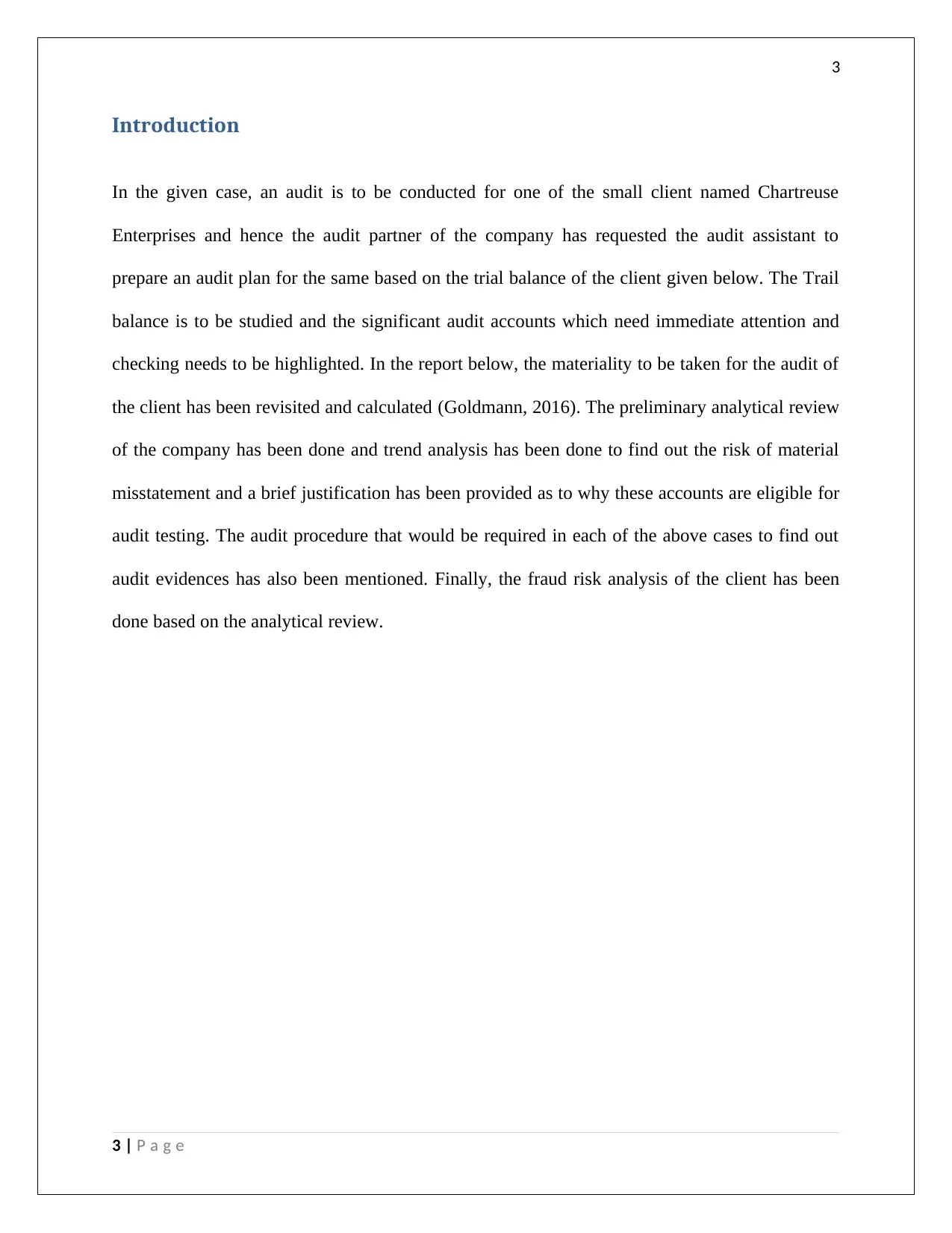
3
Introduction
In the given case, an audit is to be conducted for one of the small client named Chartreuse
Enterprises and hence the audit partner of the company has requested the audit assistant to
prepare an audit plan for the same based on the trial balance of the client given below. The Trail
balance is to be studied and the significant audit accounts which need immediate attention and
checking needs to be highlighted. In the report below, the materiality to be taken for the audit of
the client has been revisited and calculated (Goldmann, 2016). The preliminary analytical review
of the company has been done and trend analysis has been done to find out the risk of material
misstatement and a brief justification has been provided as to why these accounts are eligible for
audit testing. The audit procedure that would be required in each of the above cases to find out
audit evidences has also been mentioned. Finally, the fraud risk analysis of the client has been
done based on the analytical review.
3 | P a g e
Introduction
In the given case, an audit is to be conducted for one of the small client named Chartreuse
Enterprises and hence the audit partner of the company has requested the audit assistant to
prepare an audit plan for the same based on the trial balance of the client given below. The Trail
balance is to be studied and the significant audit accounts which need immediate attention and
checking needs to be highlighted. In the report below, the materiality to be taken for the audit of
the client has been revisited and calculated (Goldmann, 2016). The preliminary analytical review
of the company has been done and trend analysis has been done to find out the risk of material
misstatement and a brief justification has been provided as to why these accounts are eligible for
audit testing. The audit procedure that would be required in each of the above cases to find out
audit evidences has also been mentioned. Finally, the fraud risk analysis of the client has been
done based on the analytical review.
3 | P a g e
Paraphrase This Document
Need a fresh take? Get an instant paraphrase of this document with our AI Paraphraser
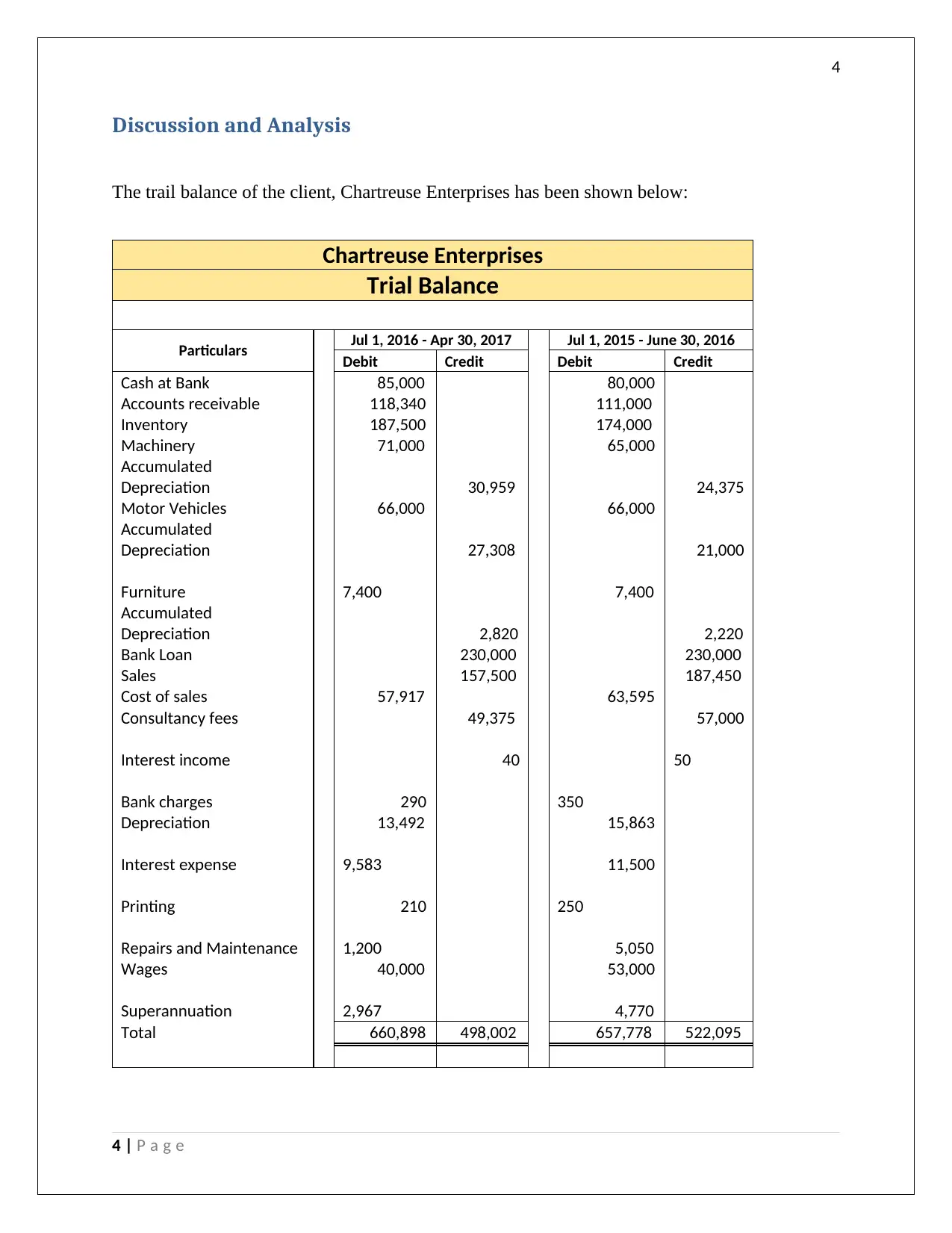
4
Discussion and Analysis
The trail balance of the client, Chartreuse Enterprises has been shown below:
Chartreuse Enterprises
Trial Balance
Particulars Jul 1, 2016 - Apr 30, 2017 Jul 1, 2015 - June 30, 2016
Debit Credit Debit Credit
Cash at Bank 85,000 80,000
Accounts receivable 118,340 111,000
Inventory 187,500 174,000
Machinery 71,000 65,000
Accumulated
Depreciation 30,959 24,375
Motor Vehicles 66,000 66,000
Accumulated
Depreciation 27,308 21,000
Furniture 7,400 7,400
Accumulated
Depreciation 2,820 2,220
Bank Loan 230,000 230,000
Sales 157,500 187,450
Cost of sales 57,917 63,595
Consultancy fees 49,375 57,000
Interest income 40 50
Bank charges 290 350
Depreciation 13,492 15,863
Interest expense 9,583 11,500
Printing 210 250
Repairs and Maintenance 1,200 5,050
Wages 40,000 53,000
Superannuation 2,967 4,770
Total 660,898 498,002 657,778 522,095
4 | P a g e
Discussion and Analysis
The trail balance of the client, Chartreuse Enterprises has been shown below:
Chartreuse Enterprises
Trial Balance
Particulars Jul 1, 2016 - Apr 30, 2017 Jul 1, 2015 - June 30, 2016
Debit Credit Debit Credit
Cash at Bank 85,000 80,000
Accounts receivable 118,340 111,000
Inventory 187,500 174,000
Machinery 71,000 65,000
Accumulated
Depreciation 30,959 24,375
Motor Vehicles 66,000 66,000
Accumulated
Depreciation 27,308 21,000
Furniture 7,400 7,400
Accumulated
Depreciation 2,820 2,220
Bank Loan 230,000 230,000
Sales 157,500 187,450
Cost of sales 57,917 63,595
Consultancy fees 49,375 57,000
Interest income 40 50
Bank charges 290 350
Depreciation 13,492 15,863
Interest expense 9,583 11,500
Printing 210 250
Repairs and Maintenance 1,200 5,050
Wages 40,000 53,000
Superannuation 2,967 4,770
Total 660,898 498,002 657,778 522,095
4 | P a g e
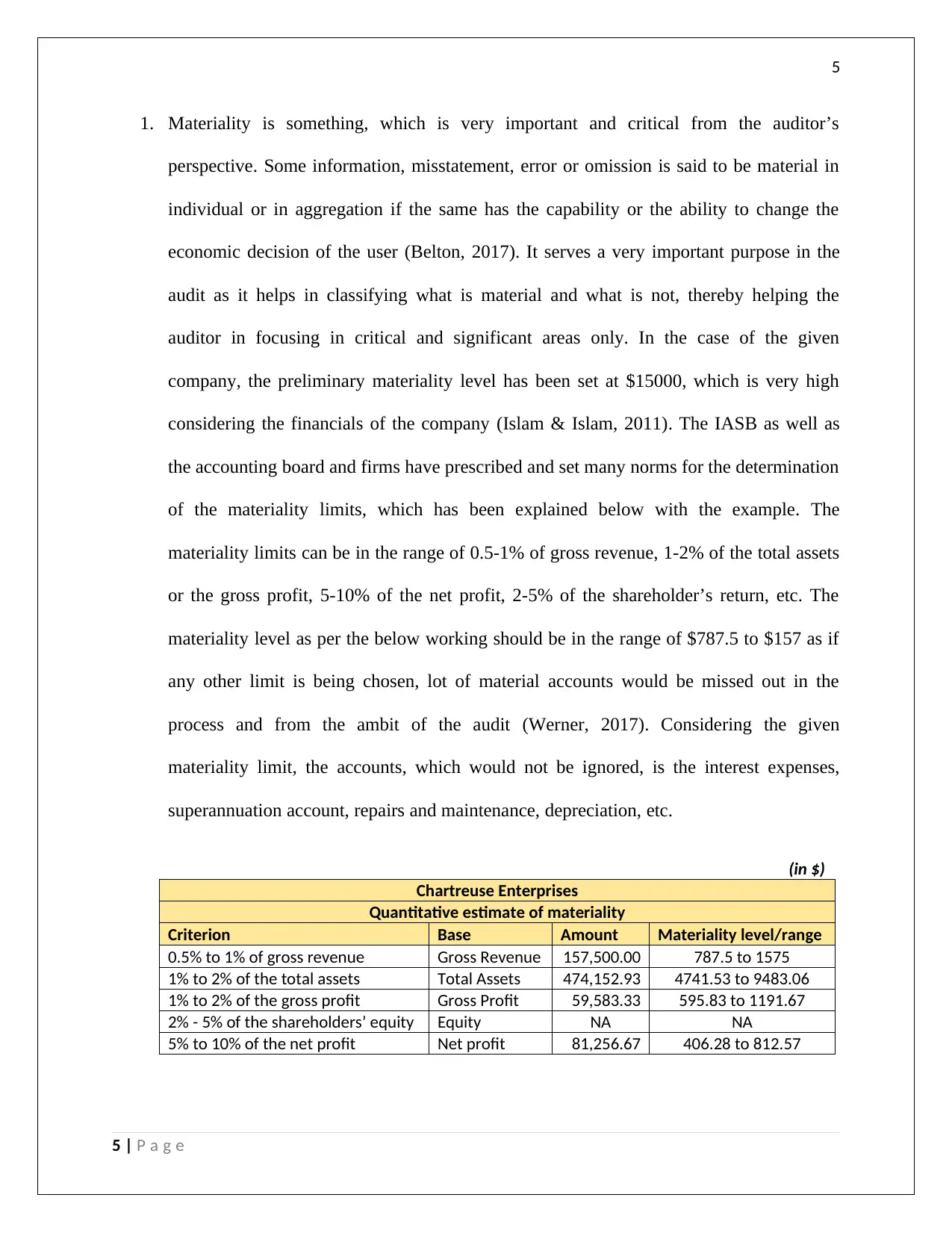
5
1. Materiality is something, which is very important and critical from the auditor’s
perspective. Some information, misstatement, error or omission is said to be material in
individual or in aggregation if the same has the capability or the ability to change the
economic decision of the user (Belton, 2017). It serves a very important purpose in the
audit as it helps in classifying what is material and what is not, thereby helping the
auditor in focusing in critical and significant areas only. In the case of the given
company, the preliminary materiality level has been set at $15000, which is very high
considering the financials of the company (Islam & Islam, 2011). The IASB as well as
the accounting board and firms have prescribed and set many norms for the determination
of the materiality limits, which has been explained below with the example. The
materiality limits can be in the range of 0.5-1% of gross revenue, 1-2% of the total assets
or the gross profit, 5-10% of the net profit, 2-5% of the shareholder’s return, etc. The
materiality level as per the below working should be in the range of $787.5 to $157 as if
any other limit is being chosen, lot of material accounts would be missed out in the
process and from the ambit of the audit (Werner, 2017). Considering the given
materiality limit, the accounts, which would not be ignored, is the interest expenses,
superannuation account, repairs and maintenance, depreciation, etc.
(in $)
Chartreuse Enterprises
Quantitative estimate of materiality
Criterion Base Amount Materiality level/range
0.5% to 1% of gross revenue Gross Revenue 157,500.00 787.5 to 1575
1% to 2% of the total assets Total Assets 474,152.93 4741.53 to 9483.06
1% to 2% of the gross profit Gross Profit 59,583.33 595.83 to 1191.67
2% - 5% of the shareholders’ equity Equity NA NA
5% to 10% of the net profit Net profit 81,256.67 406.28 to 812.57
5 | P a g e
1. Materiality is something, which is very important and critical from the auditor’s
perspective. Some information, misstatement, error or omission is said to be material in
individual or in aggregation if the same has the capability or the ability to change the
economic decision of the user (Belton, 2017). It serves a very important purpose in the
audit as it helps in classifying what is material and what is not, thereby helping the
auditor in focusing in critical and significant areas only. In the case of the given
company, the preliminary materiality level has been set at $15000, which is very high
considering the financials of the company (Islam & Islam, 2011). The IASB as well as
the accounting board and firms have prescribed and set many norms for the determination
of the materiality limits, which has been explained below with the example. The
materiality limits can be in the range of 0.5-1% of gross revenue, 1-2% of the total assets
or the gross profit, 5-10% of the net profit, 2-5% of the shareholder’s return, etc. The
materiality level as per the below working should be in the range of $787.5 to $157 as if
any other limit is being chosen, lot of material accounts would be missed out in the
process and from the ambit of the audit (Werner, 2017). Considering the given
materiality limit, the accounts, which would not be ignored, is the interest expenses,
superannuation account, repairs and maintenance, depreciation, etc.
(in $)
Chartreuse Enterprises
Quantitative estimate of materiality
Criterion Base Amount Materiality level/range
0.5% to 1% of gross revenue Gross Revenue 157,500.00 787.5 to 1575
1% to 2% of the total assets Total Assets 474,152.93 4741.53 to 9483.06
1% to 2% of the gross profit Gross Profit 59,583.33 595.83 to 1191.67
2% - 5% of the shareholders’ equity Equity NA NA
5% to 10% of the net profit Net profit 81,256.67 406.28 to 812.57
5 | P a g e
⊘ This is a preview!⊘
Do you want full access?
Subscribe today to unlock all pages.

Trusted by 1+ million students worldwide
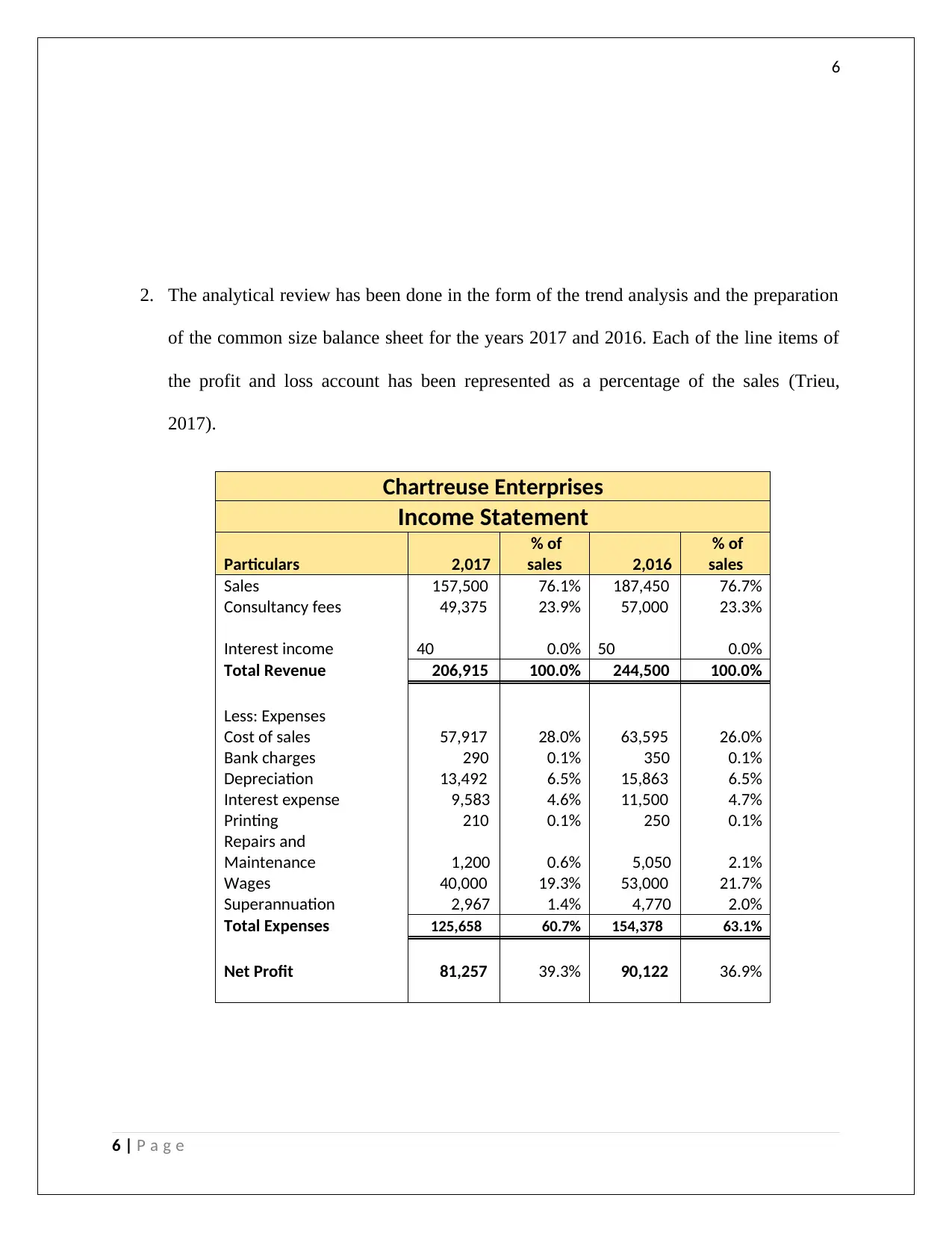
6
2. The analytical review has been done in the form of the trend analysis and the preparation
of the common size balance sheet for the years 2017 and 2016. Each of the line items of
the profit and loss account has been represented as a percentage of the sales (Trieu,
2017).
Chartreuse Enterprises
Income Statement
Particulars 2,017
% of
sales 2,016
% of
sales
Sales 157,500 76.1% 187,450 76.7%
Consultancy fees 49,375 23.9% 57,000 23.3%
Interest income 40 0.0% 50 0.0%
Total Revenue 206,915 100.0% 244,500 100.0%
Less: Expenses
Cost of sales 57,917 28.0% 63,595 26.0%
Bank charges 290 0.1% 350 0.1%
Depreciation 13,492 6.5% 15,863 6.5%
Interest expense 9,583 4.6% 11,500 4.7%
Printing 210 0.1% 250 0.1%
Repairs and
Maintenance 1,200 0.6% 5,050 2.1%
Wages 40,000 19.3% 53,000 21.7%
Superannuation 2,967 1.4% 4,770 2.0%
Total Expenses 125,658 60.7% 154,378 63.1%
Net Profit 81,257 39.3% 90,122 36.9%
6 | P a g e
2. The analytical review has been done in the form of the trend analysis and the preparation
of the common size balance sheet for the years 2017 and 2016. Each of the line items of
the profit and loss account has been represented as a percentage of the sales (Trieu,
2017).
Chartreuse Enterprises
Income Statement
Particulars 2,017
% of
sales 2,016
% of
sales
Sales 157,500 76.1% 187,450 76.7%
Consultancy fees 49,375 23.9% 57,000 23.3%
Interest income 40 0.0% 50 0.0%
Total Revenue 206,915 100.0% 244,500 100.0%
Less: Expenses
Cost of sales 57,917 28.0% 63,595 26.0%
Bank charges 290 0.1% 350 0.1%
Depreciation 13,492 6.5% 15,863 6.5%
Interest expense 9,583 4.6% 11,500 4.7%
Printing 210 0.1% 250 0.1%
Repairs and
Maintenance 1,200 0.6% 5,050 2.1%
Wages 40,000 19.3% 53,000 21.7%
Superannuation 2,967 1.4% 4,770 2.0%
Total Expenses 125,658 60.7% 154,378 63.1%
Net Profit 81,257 39.3% 90,122 36.9%
6 | P a g e
Paraphrase This Document
Need a fresh take? Get an instant paraphrase of this document with our AI Paraphraser
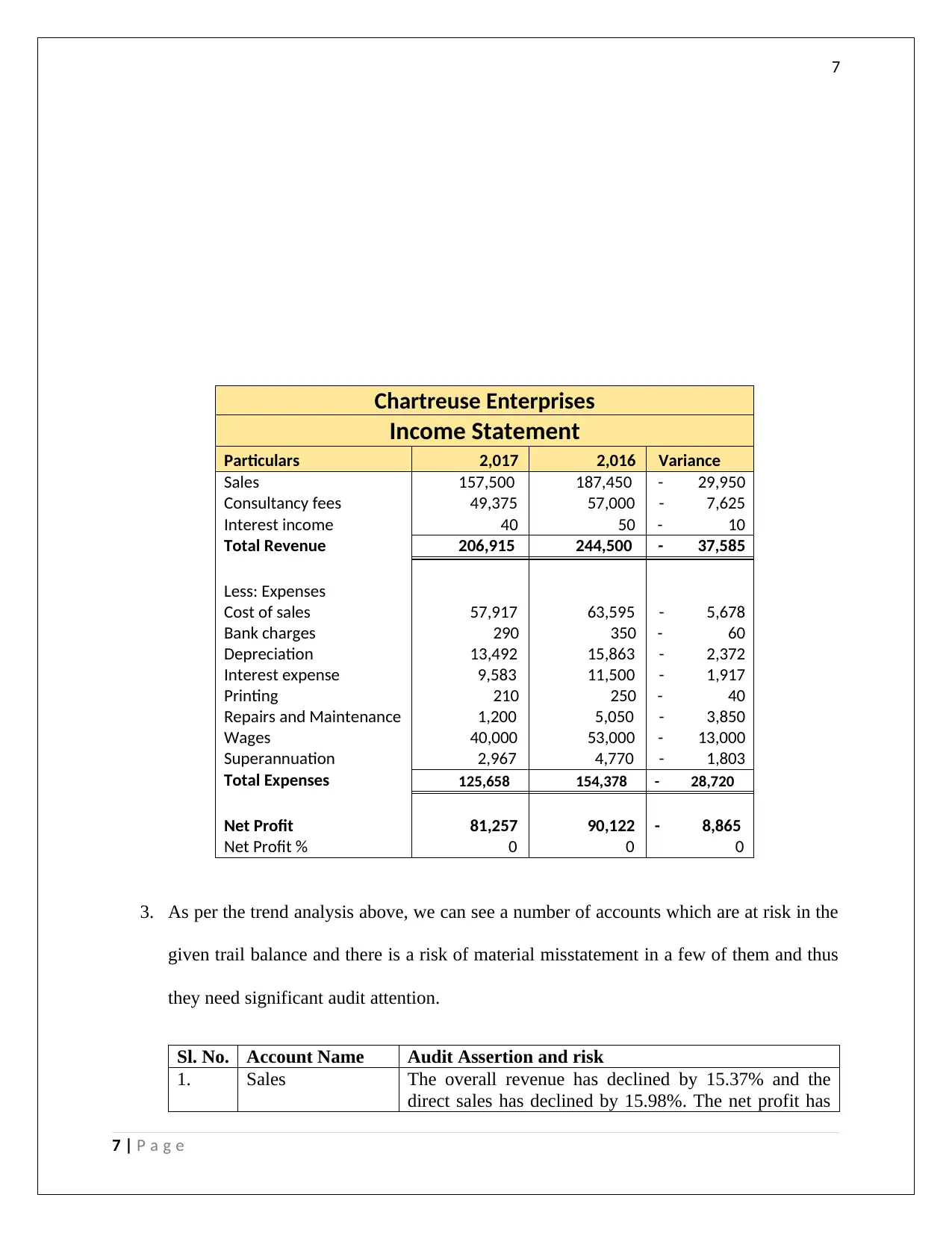
7
Chartreuse Enterprises
Income Statement
Particulars 2,017 2,016 Variance
Sales 157,500 187,450 - 29,950
Consultancy fees 49,375 57,000 - 7,625
Interest income 40 50 - 10
Total Revenue 206,915 244,500 - 37,585
Less: Expenses
Cost of sales 57,917 63,595 - 5,678
Bank charges 290 350 - 60
Depreciation 13,492 15,863 - 2,372
Interest expense 9,583 11,500 - 1,917
Printing 210 250 - 40
Repairs and Maintenance 1,200 5,050 - 3,850
Wages 40,000 53,000 - 13,000
Superannuation 2,967 4,770 - 1,803
Total Expenses 125,658 154,378 - 28,720
Net Profit 81,257 90,122 - 8,865
Net Profit % 0 0 0
3. As per the trend analysis above, we can see a number of accounts which are at risk in the
given trail balance and there is a risk of material misstatement in a few of them and thus
they need significant audit attention.
Sl. No. Account Name Audit Assertion and risk
1. Sales The overall revenue has declined by 15.37% and the
direct sales has declined by 15.98%. The net profit has
7 | P a g e
Chartreuse Enterprises
Income Statement
Particulars 2,017 2,016 Variance
Sales 157,500 187,450 - 29,950
Consultancy fees 49,375 57,000 - 7,625
Interest income 40 50 - 10
Total Revenue 206,915 244,500 - 37,585
Less: Expenses
Cost of sales 57,917 63,595 - 5,678
Bank charges 290 350 - 60
Depreciation 13,492 15,863 - 2,372
Interest expense 9,583 11,500 - 1,917
Printing 210 250 - 40
Repairs and Maintenance 1,200 5,050 - 3,850
Wages 40,000 53,000 - 13,000
Superannuation 2,967 4,770 - 1,803
Total Expenses 125,658 154,378 - 28,720
Net Profit 81,257 90,122 - 8,865
Net Profit % 0 0 0
3. As per the trend analysis above, we can see a number of accounts which are at risk in the
given trail balance and there is a risk of material misstatement in a few of them and thus
they need significant audit attention.
Sl. No. Account Name Audit Assertion and risk
1. Sales The overall revenue has declined by 15.37% and the
direct sales has declined by 15.98%. The net profit has
7 | P a g e
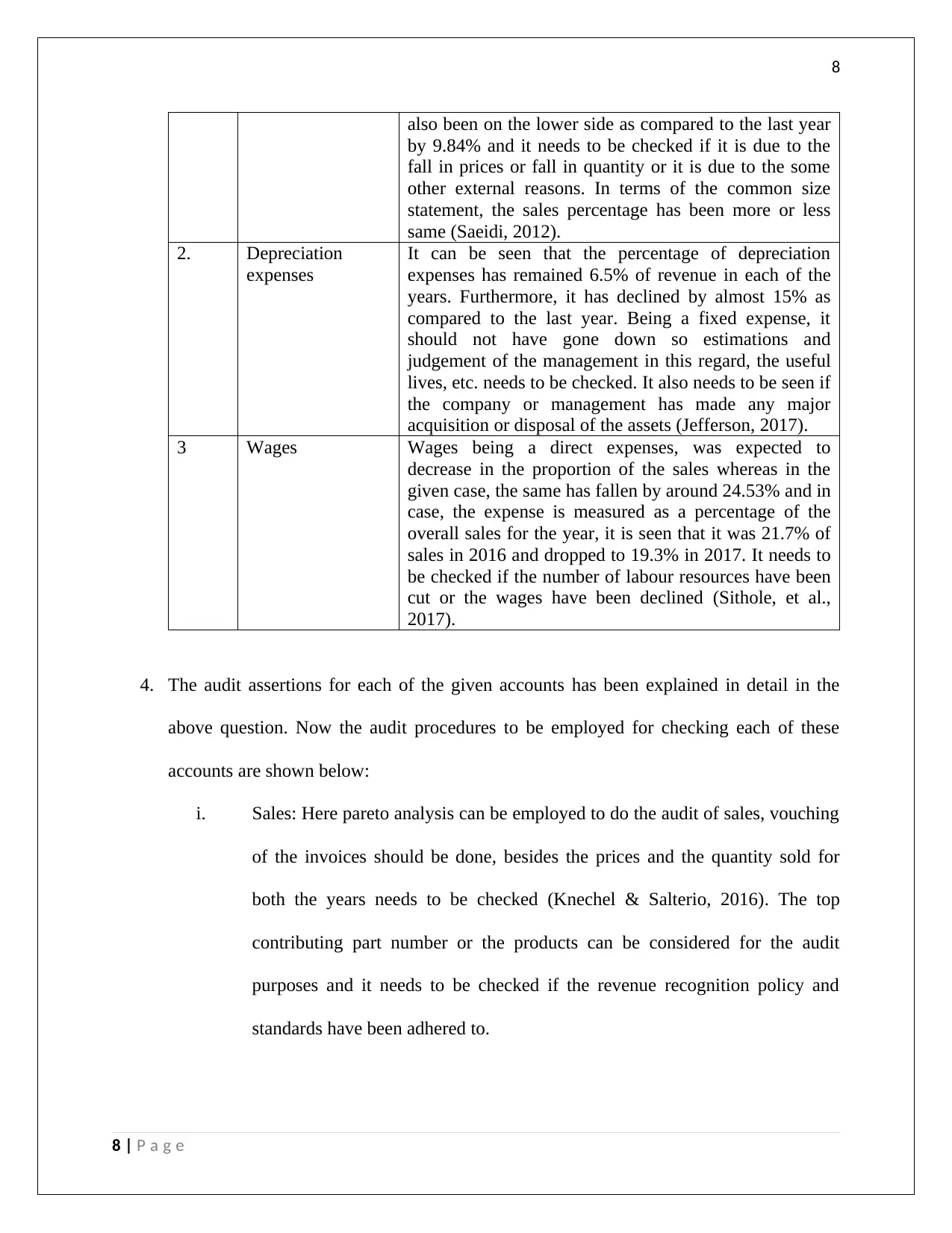
8
also been on the lower side as compared to the last year
by 9.84% and it needs to be checked if it is due to the
fall in prices or fall in quantity or it is due to the some
other external reasons. In terms of the common size
statement, the sales percentage has been more or less
same (Saeidi, 2012).
2. Depreciation
expenses
It can be seen that the percentage of depreciation
expenses has remained 6.5% of revenue in each of the
years. Furthermore, it has declined by almost 15% as
compared to the last year. Being a fixed expense, it
should not have gone down so estimations and
judgement of the management in this regard, the useful
lives, etc. needs to be checked. It also needs to be seen if
the company or management has made any major
acquisition or disposal of the assets (Jefferson, 2017).
3 Wages Wages being a direct expenses, was expected to
decrease in the proportion of the sales whereas in the
given case, the same has fallen by around 24.53% and in
case, the expense is measured as a percentage of the
overall sales for the year, it is seen that it was 21.7% of
sales in 2016 and dropped to 19.3% in 2017. It needs to
be checked if the number of labour resources have been
cut or the wages have been declined (Sithole, et al.,
2017).
4. The audit assertions for each of the given accounts has been explained in detail in the
above question. Now the audit procedures to be employed for checking each of these
accounts are shown below:
i. Sales: Here pareto analysis can be employed to do the audit of sales, vouching
of the invoices should be done, besides the prices and the quantity sold for
both the years needs to be checked (Knechel & Salterio, 2016). The top
contributing part number or the products can be considered for the audit
purposes and it needs to be checked if the revenue recognition policy and
standards have been adhered to.
8 | P a g e
also been on the lower side as compared to the last year
by 9.84% and it needs to be checked if it is due to the
fall in prices or fall in quantity or it is due to the some
other external reasons. In terms of the common size
statement, the sales percentage has been more or less
same (Saeidi, 2012).
2. Depreciation
expenses
It can be seen that the percentage of depreciation
expenses has remained 6.5% of revenue in each of the
years. Furthermore, it has declined by almost 15% as
compared to the last year. Being a fixed expense, it
should not have gone down so estimations and
judgement of the management in this regard, the useful
lives, etc. needs to be checked. It also needs to be seen if
the company or management has made any major
acquisition or disposal of the assets (Jefferson, 2017).
3 Wages Wages being a direct expenses, was expected to
decrease in the proportion of the sales whereas in the
given case, the same has fallen by around 24.53% and in
case, the expense is measured as a percentage of the
overall sales for the year, it is seen that it was 21.7% of
sales in 2016 and dropped to 19.3% in 2017. It needs to
be checked if the number of labour resources have been
cut or the wages have been declined (Sithole, et al.,
2017).
4. The audit assertions for each of the given accounts has been explained in detail in the
above question. Now the audit procedures to be employed for checking each of these
accounts are shown below:
i. Sales: Here pareto analysis can be employed to do the audit of sales, vouching
of the invoices should be done, besides the prices and the quantity sold for
both the years needs to be checked (Knechel & Salterio, 2016). The top
contributing part number or the products can be considered for the audit
purposes and it needs to be checked if the revenue recognition policy and
standards have been adhered to.
8 | P a g e
⊘ This is a preview!⊘
Do you want full access?
Subscribe today to unlock all pages.

Trusted by 1+ million students worldwide
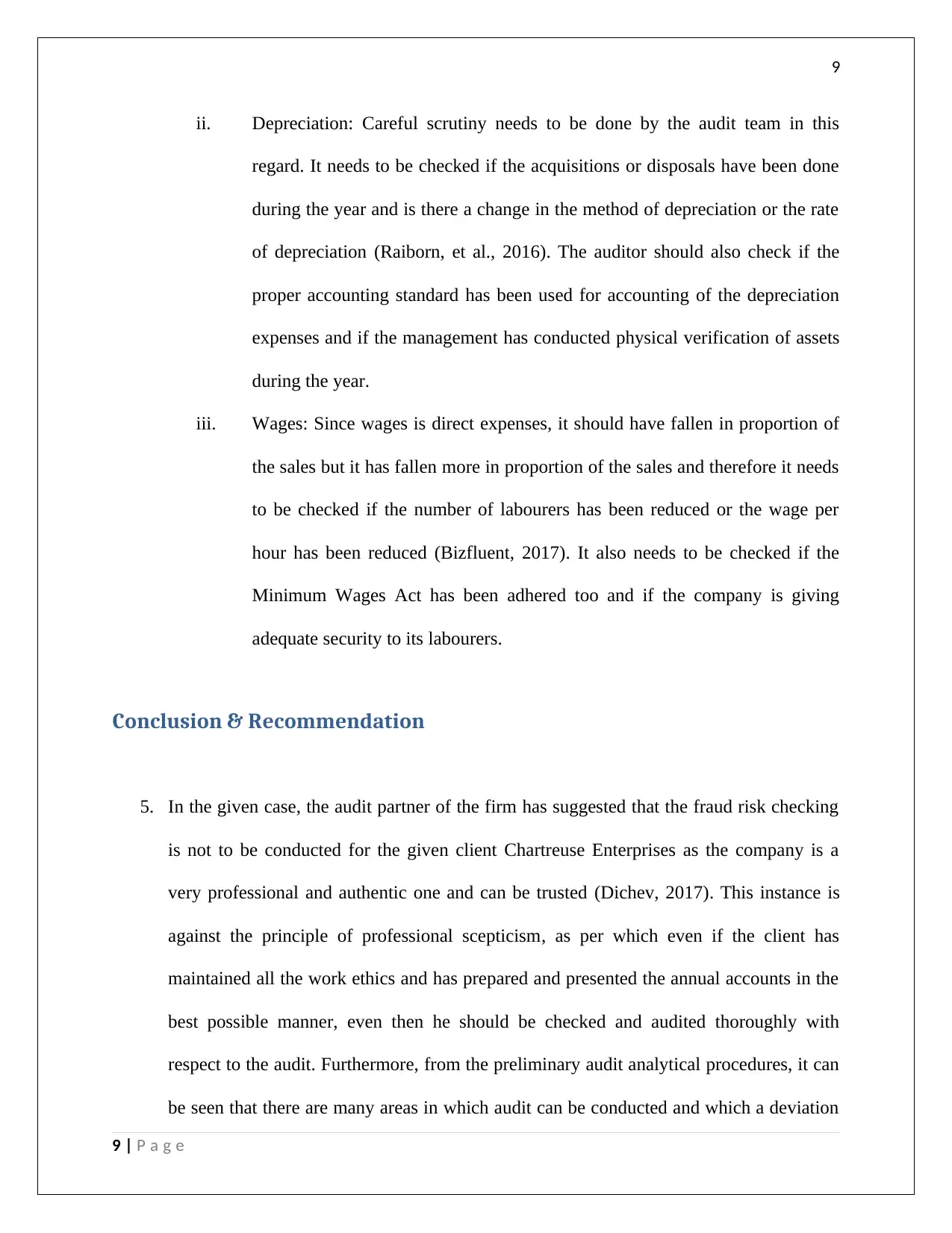
9
ii. Depreciation: Careful scrutiny needs to be done by the audit team in this
regard. It needs to be checked if the acquisitions or disposals have been done
during the year and is there a change in the method of depreciation or the rate
of depreciation (Raiborn, et al., 2016). The auditor should also check if the
proper accounting standard has been used for accounting of the depreciation
expenses and if the management has conducted physical verification of assets
during the year.
iii. Wages: Since wages is direct expenses, it should have fallen in proportion of
the sales but it has fallen more in proportion of the sales and therefore it needs
to be checked if the number of labourers has been reduced or the wage per
hour has been reduced (Bizfluent, 2017). It also needs to be checked if the
Minimum Wages Act has been adhered too and if the company is giving
adequate security to its labourers.
Conclusion & Recommendation
5. In the given case, the audit partner of the firm has suggested that the fraud risk checking
is not to be conducted for the given client Chartreuse Enterprises as the company is a
very professional and authentic one and can be trusted (Dichev, 2017). This instance is
against the principle of professional scepticism, as per which even if the client has
maintained all the work ethics and has prepared and presented the annual accounts in the
best possible manner, even then he should be checked and audited thoroughly with
respect to the audit. Furthermore, from the preliminary audit analytical procedures, it can
be seen that there are many areas in which audit can be conducted and which a deviation
9 | P a g e
ii. Depreciation: Careful scrutiny needs to be done by the audit team in this
regard. It needs to be checked if the acquisitions or disposals have been done
during the year and is there a change in the method of depreciation or the rate
of depreciation (Raiborn, et al., 2016). The auditor should also check if the
proper accounting standard has been used for accounting of the depreciation
expenses and if the management has conducted physical verification of assets
during the year.
iii. Wages: Since wages is direct expenses, it should have fallen in proportion of
the sales but it has fallen more in proportion of the sales and therefore it needs
to be checked if the number of labourers has been reduced or the wage per
hour has been reduced (Bizfluent, 2017). It also needs to be checked if the
Minimum Wages Act has been adhered too and if the company is giving
adequate security to its labourers.
Conclusion & Recommendation
5. In the given case, the audit partner of the firm has suggested that the fraud risk checking
is not to be conducted for the given client Chartreuse Enterprises as the company is a
very professional and authentic one and can be trusted (Dichev, 2017). This instance is
against the principle of professional scepticism, as per which even if the client has
maintained all the work ethics and has prepared and presented the annual accounts in the
best possible manner, even then he should be checked and audited thoroughly with
respect to the audit. Furthermore, from the preliminary audit analytical procedures, it can
be seen that there are many areas in which audit can be conducted and which a deviation
9 | P a g e
Paraphrase This Document
Need a fresh take? Get an instant paraphrase of this document with our AI Paraphraser
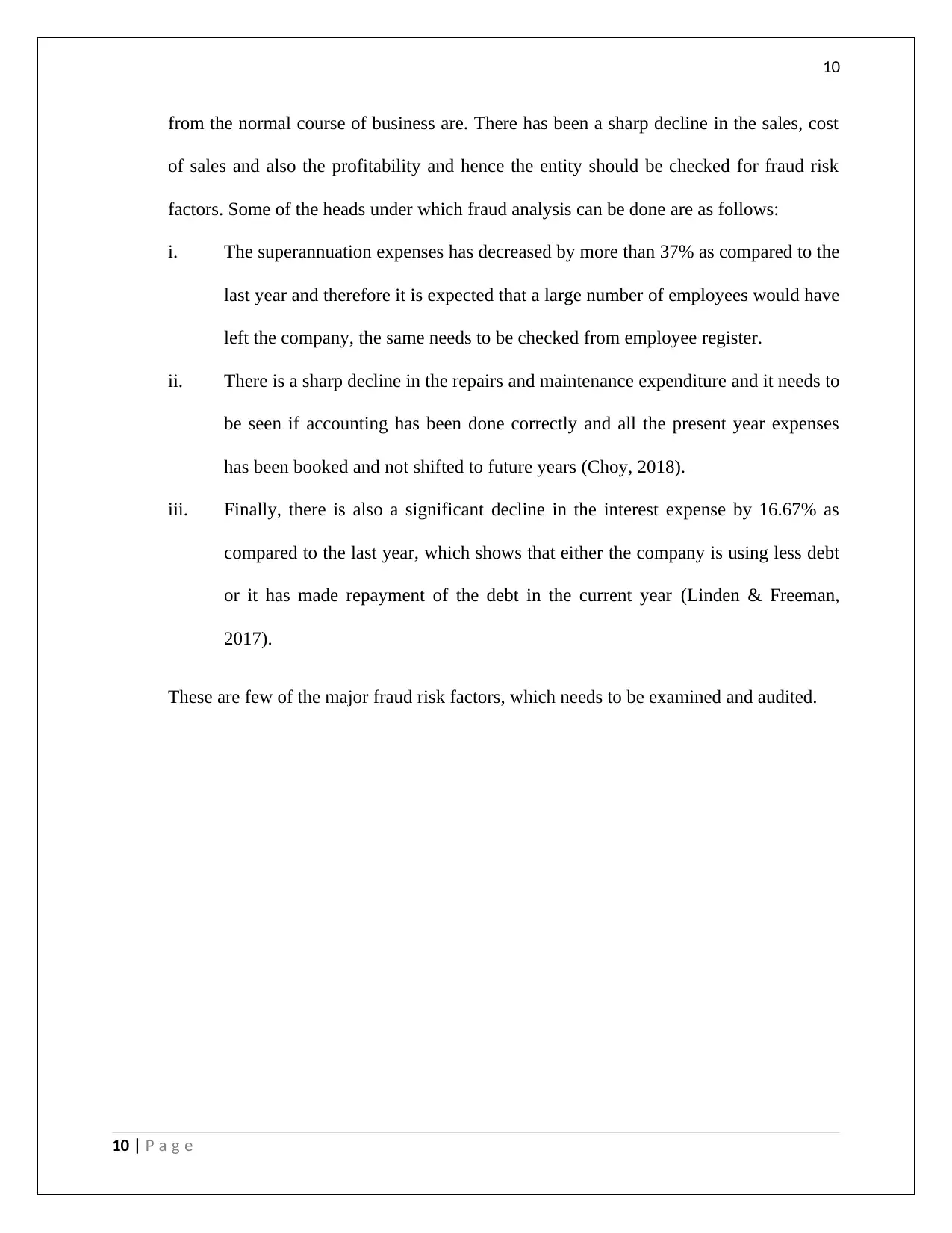
10
from the normal course of business are. There has been a sharp decline in the sales, cost
of sales and also the profitability and hence the entity should be checked for fraud risk
factors. Some of the heads under which fraud analysis can be done are as follows:
i. The superannuation expenses has decreased by more than 37% as compared to the
last year and therefore it is expected that a large number of employees would have
left the company, the same needs to be checked from employee register.
ii. There is a sharp decline in the repairs and maintenance expenditure and it needs to
be seen if accounting has been done correctly and all the present year expenses
has been booked and not shifted to future years (Choy, 2018).
iii. Finally, there is also a significant decline in the interest expense by 16.67% as
compared to the last year, which shows that either the company is using less debt
or it has made repayment of the debt in the current year (Linden & Freeman,
2017).
These are few of the major fraud risk factors, which needs to be examined and audited.
10 | P a g e
from the normal course of business are. There has been a sharp decline in the sales, cost
of sales and also the profitability and hence the entity should be checked for fraud risk
factors. Some of the heads under which fraud analysis can be done are as follows:
i. The superannuation expenses has decreased by more than 37% as compared to the
last year and therefore it is expected that a large number of employees would have
left the company, the same needs to be checked from employee register.
ii. There is a sharp decline in the repairs and maintenance expenditure and it needs to
be seen if accounting has been done correctly and all the present year expenses
has been booked and not shifted to future years (Choy, 2018).
iii. Finally, there is also a significant decline in the interest expense by 16.67% as
compared to the last year, which shows that either the company is using less debt
or it has made repayment of the debt in the current year (Linden & Freeman,
2017).
These are few of the major fraud risk factors, which needs to be examined and audited.
10 | P a g e
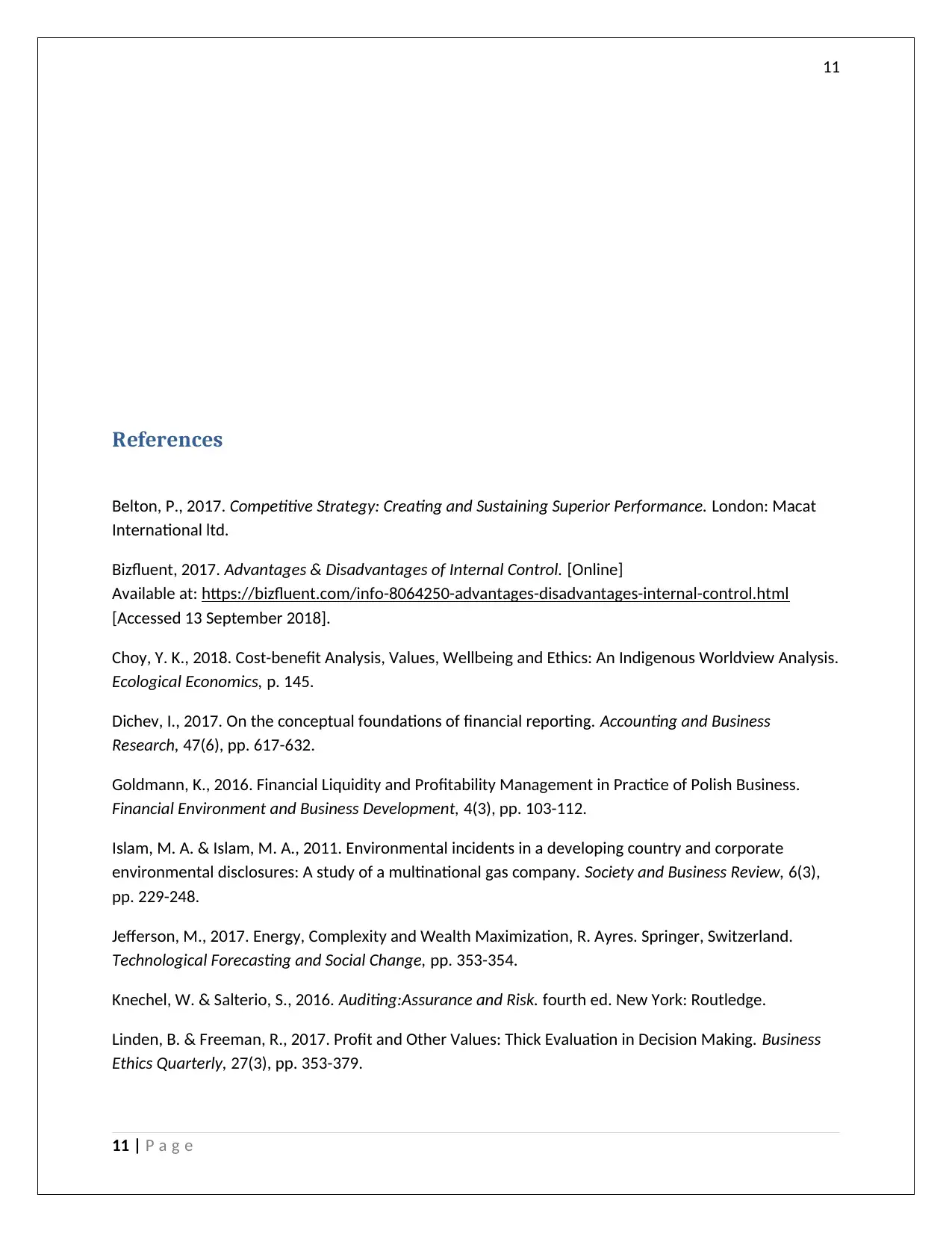
11
References
Belton, P., 2017. Competitive Strategy: Creating and Sustaining Superior Performance. London: Macat
International ltd.
Bizfluent, 2017. Advantages & Disadvantages of Internal Control. [Online]
Available at: https://bizfluent.com/info-8064250-advantages-disadvantages-internal-control.html
[Accessed 13 September 2018].
Choy, Y. K., 2018. Cost-benefit Analysis, Values, Wellbeing and Ethics: An Indigenous Worldview Analysis.
Ecological Economics, p. 145.
Dichev, I., 2017. On the conceptual foundations of financial reporting. Accounting and Business
Research, 47(6), pp. 617-632.
Goldmann, K., 2016. Financial Liquidity and Profitability Management in Practice of Polish Business.
Financial Environment and Business Development, 4(3), pp. 103-112.
Islam, M. A. & Islam, M. A., 2011. Environmental incidents in a developing country and corporate
environmental disclosures: A study of a multinational gas company. Society and Business Review, 6(3),
pp. 229-248.
Jefferson, M., 2017. Energy, Complexity and Wealth Maximization, R. Ayres. Springer, Switzerland.
Technological Forecasting and Social Change, pp. 353-354.
Knechel, W. & Salterio, S., 2016. Auditing:Assurance and Risk. fourth ed. New York: Routledge.
Linden, B. & Freeman, R., 2017. Profit and Other Values: Thick Evaluation in Decision Making. Business
Ethics Quarterly, 27(3), pp. 353-379.
11 | P a g e
References
Belton, P., 2017. Competitive Strategy: Creating and Sustaining Superior Performance. London: Macat
International ltd.
Bizfluent, 2017. Advantages & Disadvantages of Internal Control. [Online]
Available at: https://bizfluent.com/info-8064250-advantages-disadvantages-internal-control.html
[Accessed 13 September 2018].
Choy, Y. K., 2018. Cost-benefit Analysis, Values, Wellbeing and Ethics: An Indigenous Worldview Analysis.
Ecological Economics, p. 145.
Dichev, I., 2017. On the conceptual foundations of financial reporting. Accounting and Business
Research, 47(6), pp. 617-632.
Goldmann, K., 2016. Financial Liquidity and Profitability Management in Practice of Polish Business.
Financial Environment and Business Development, 4(3), pp. 103-112.
Islam, M. A. & Islam, M. A., 2011. Environmental incidents in a developing country and corporate
environmental disclosures: A study of a multinational gas company. Society and Business Review, 6(3),
pp. 229-248.
Jefferson, M., 2017. Energy, Complexity and Wealth Maximization, R. Ayres. Springer, Switzerland.
Technological Forecasting and Social Change, pp. 353-354.
Knechel, W. & Salterio, S., 2016. Auditing:Assurance and Risk. fourth ed. New York: Routledge.
Linden, B. & Freeman, R., 2017. Profit and Other Values: Thick Evaluation in Decision Making. Business
Ethics Quarterly, 27(3), pp. 353-379.
11 | P a g e
⊘ This is a preview!⊘
Do you want full access?
Subscribe today to unlock all pages.

Trusted by 1+ million students worldwide
1 out of 13
Related Documents
Your All-in-One AI-Powered Toolkit for Academic Success.
+13062052269
info@desklib.com
Available 24*7 on WhatsApp / Email
![[object Object]](/_next/static/media/star-bottom.7253800d.svg)
Unlock your academic potential
Copyright © 2020–2025 A2Z Services. All Rights Reserved. Developed and managed by ZUCOL.




